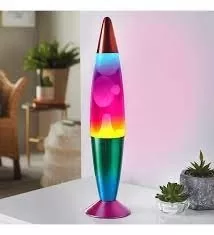Lava lamps have been a popular home decor item for over half a century, and they continue to be a fun and funky addition to any room in your home.

With their vibrant colors and mesmerizing motion, these lamps add a unique touch to any space. In this article, we’ll explore the history and science behind lava lamps, as well as offer tips on choosing the right one for your home, where to place it, and how to care for it.
Whether you’re a longtime fan of lava lamps or are new to their appeal, read on to learn more about how they can enhance your home decor.
Large Lava lamps were invented by British accountant Edward Craven Walker in 1963. Inspired by a homemade egg timer made of a cocktail shaker filled with liquids and glitter, he began experimenting with different combinations of oil and water to create the unique visual effect that we now associate with lava lamps.
Walker founded the company Mathmos (originally called Crestworth Ltd.) to produce and sell his invention. The name “Astro Lamp” was used at first, but the product was soon rebranded as the “Lava Lamp,” a name that has stuck ever since.
Lava lamps quickly became popular in the 1960s, often seen in music venues and clubs. The lamps were embraced by the counterculture movement as a symbol of peace, love, and individuality. The psychedelic designs of the lamps fit perfectly with the era’s bright colors and bold patterns.
Although the popularity of lava lamps waned in the following decades, they never completely went out of style. In recent years, they have made a comeback and are once again a sought-after home decor item. Lava lamps are now available in a wide range of sizes, shapes, and colors, and they are popular among people of all ages.
Lava lamps work through a combination of heat and density. The lamp consists of a glass container filled with a special liquid, often a combination of water and wax or oil. A light bulb underneath the container heats the liquid, causing the wax or oil to expand and rise to the top of the container. As it cools, it sinks back down to the bottom, creating a continuous cycle of motion.
The unique shapes and designs that lava lamps produce are created by the different densities of the liquids used. The wax or oil used in the lamps is usually less dense than the water, so it floats to the top when heated. As it cools and becomes denser, it sinks back down. The process repeats, resulting in the characteristic blobs and waves that move around inside the lamp.
Different colors and designs can be achieved by adding different dyes or pigments to the liquids inside the lamp. Some lamps also have special effects, such as glitter or shimmer, added to the liquid for an even more eye-catching display.
Read Also:
When choosing a lava lamp, there are several things to consider to ensure you get the right one for your home. Here are some factors to keep in mind:
With these factors in mind, you’re sure to find the perfect lava lamp for your home.
Lava lamps can be placed in various locations throughout your home. Here are a few ideas to get you started:
Remember to place your lava lamp on a flat and stable surface, away from any flammable materials or objects that could cause it to tip over. Additionally, ensure the lamp is placed in a location where it won’t be knocked over or damaged.
Proper maintenance and safety are crucial when it comes to owning and enjoying a pink lava lamp. Here are some tips to keep your lamp in good condition and prevent accidents:
By following these safety and maintenance guidelines, you can ensure that your lava lamp remains a safe and enjoyable addition to your home decor.
In conclusion, lava lamps are a fun and funky addition to any home decor. The unique design and colorful displays make them perfect for adding a pop of color and ambiance to any space. When choosing a lava lamp, it’s important to consider factors such as size, color, and design, as well as safety and quality.
Proper maintenance and safety practices are also crucial to ensure that your lava lamp remains a safe and enjoyable part of your home. Overall, a lava lamp is a great way to add a bit of retro-inspired style to your home, while also creating a calming and relaxing atmosphere.